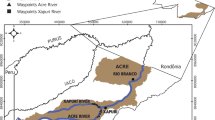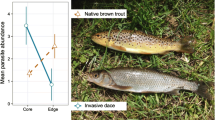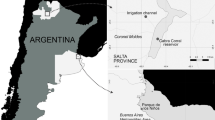Abstract
One of the best examples of rapid displacement of native species by an invader is the eradication of native Artemia salina and A. parthenogenetica in the Mediterranean by the introduced American A. franciscana. Previous studies based on sampling from limited time periods suggest that the success of the American species as a competitor may be due partly to different parasite burden, since native Artemia spp. have high cestode infection rates regulating their density. The aim of this study is to test the hypothesis that the helminth infection in A. franciscana in its invasive range is low throughout its annual life cycle. Samples of A. franciscana were collected every second month from La Tapa saltern (Andalusia) during one year. Five helminth species were recorded: cestodes Flamingolepis liguloides, F. flamingo, Gynandrotaenia stammeri (all flamingo parasites), Eurycestus avoceti (a shorebird parasite) and larval spirurids of the Acuariinae (the first record of nematodes in Artemia). The overall infection rate was low, with total prevalence 5.9% and prevalence of individual parasite species between 0.2 and 3.2%. The mean abundance of helminths was 0.005–0.155 (av. 0.068), 5–13 times lower than in native congeners. Waterbird counts indicate that the low infection rates cannot be explained by lack of definitive hosts. The results are consistent with the hypothesis that helminths have no regulating effect on the invasive brine shrimp in the Mediterranean. The replacement of the native populations by the invader can be partially explained by a competition mediated by parasites/predators through a differential impact on host fitness.
Similar content being viewed by others
References
Amarouayache M., Derbal F., Kara M.H. 2009. The parasitism of Flamingolepis liguloides (Gervais, 1847) (Cestoda, Hymenolepididae) in Artemia salina (Crustacea, Branchiopoda) in two saline lakes in Algeria. Acta Parasitologica, 54, 330–334. DOI: 10.2478/s11686-009-0049-8.
Amat F., Gozalbo A., Navarro J.C., Hontoria F., Varó I. 1991a. Some aspects of Artemia biology affected by cestode parasitism. Hydrobiologia, 212, 39–44. DOI: 10.1007/978-94-011-3366-1_6.
Amat F., Illescas P., Fernández J. 1991b. Brine shrimp Artemia from Spanish Mediterranean salterns parasitized by Flamingolepis liguloides (Cestoda, Hymenolepididae) cysticercoids. Vie et Milieu, 41, 237–244.
Amat F., Hontoria F., Ruiz O., Green A.J., Sánchez M.I., Figuerola J., Hortas F. 2005. The American brine shrimp Artemia franciscana as an exotic invasive species in the Western Mediterranean. Biological Invasions, 7, 37–47. DOI: 10.1007/s10530-004-9634-9.
Amat F., Hontoria F., Navarro J.C., Vieira N., Mura G. 2007. Biodiversity loss in the genus Artemia in the Western Mediterranean region. Limnetica, 26, 387–404.
Anderson R.C. 2000. Nematode Parasites of Vertebrates. Their Development and Transmission. 2nd Edition. CABI Publishing, Wallingford, Oxon (UK), 650 pp.
Anderson R.C., Wong P.L. 1992. Western Palaearctic and Ethiopian species of Skrjabinoclava (Nematoda: Acuarioidea) in Icelandic shorebirds (Aves: Charadriiformes) en route to breed in the New World and Greenland. Canadian Journal of Zoology, 70, 1861–1877. DOI: 10.1139/z92-255.
Austin B., Allen D.A. (1982) Microbiology of laboratory-hatched brine shrimp (Artemia). Aquaculture, 26: 369–383. DOI: 10.1016/0044-8486(82)90170-3.
Bartlett C.M., Anderson R.C., Wong P.L. 1989. Development of Skrjabinocerca prima (Nematoda: Acuarioidea) in Hyalella azteca (Amphipoda) and Recurvirostra americana (Aves: Charadriiformes), with comments on its precocity. Canadian Journal of Zoology, 67, 2883–2892. DOI: 10.1139/z89-409.
Baruš V., Sergeeva T.P., Sonin M.D., Ryzhikov K.M. 1978. Helminths of Fish-eating Birds of the Palaearctic Region. I. Nematoda. Academia, Moscow and Prague, 319 pp.
Belovsky G.E., Stephens D., Perschon C., Birdsey P., Paul D., Naftz D., Baskin R., Larson C., Mellison C., Luft J., Mosley R., Mahon H., Van Leeuwen J., Allen D.V. 2011. The Great Salt Lake Ecosystem (Utah, USA): long term data and a structural equation approach. Ecosphere, 2, Article 33. DOI: 1890/ES10-00091.1
Bush A.O., Lafferty K.D., Lotz J.M., Shostak A.W. 1997. Parasitology meets ecology on its own terms: Margolis et al. revisited. Journal of Parasitology, 83, 575–583.
Chabaud A.G. 1950. Cycle évolutif de Synhimantus (Desportesius) spinulatus (Nematoda, Acuariidae). Annales de Parasitologie Humaine et Comparée, 25, 150–166.
Chabaud A.G. 1975. Keys to the genera of the order Spirurida. Part 2. Spiruroidea, Habronematoidea and Acuarioidea. In: Anderson RC, Chabaud AG and Willmott S (eds) CIH keys to the nematode parasites of vertebrates, No. 3. Commonwealth Agricultural Bureaux, Farnham Royal, Bucks, 58 pp.
Consejería de Medio Ambiente 2007. Counts of waterbirds at La Tapa Saltpans 2006–2007 (unpublished report). Programa de Emergencias, Control Epidemiológico y Seguimiento de Fauna Silvestre de Andalucía. Junta de Andalucía.
Dunn A.M. 2009. Parasites and biological invasions. Advances in Parasitology, 68, 161–184. DOI: 10.1016/S0065-308X(08)00607-6
Dunn A.M., Torchin M.E., Hatcher M.J., Kotanen P.M., Blumenthal D.M., Byers J.E., Coon C.A.C., Frankel V.M., Holt R.D., Hufbauer R.A., Kanarek A.R., Schierenbeck K.A., Wolfe L.M., Perkins S.E. 2012. Indirect effects of parasites in invasions. Functional Ecology, 26, 1262–1274. DOI: 10.1111/j.1365-2435.2012.02041.x.
Gabrion C., MacDonald G., Boy V. 1982. Dynamique des populations larvaires du cestode Flamingolepis liguloides dans une population d’Artemia en Camargue. Acta Oecologica, 3, 273–293.
Georgiev B.B., Sánchez M.I., Green A.J., Nikolov P.N., Vasileva G.P., Mavrodieva R.S. 2005. Cestodes from Artemia parthenogenetica (Crustacea, Branchiopoda) in the Odiel Marshes, Spain: a systematic survey. Acta Parasitologica, 50, 105–117.
Georgiev B.B., Sánchez M.I., Vasileva G.P., Nikolov P.N., Green A.J. 2007. Cestode parasitism in invasive and native brine shrimps (Artemia spp.) as a possible factor promoting the rapid invasion of A. franciscana in the Mediterranean region. Parasitology Research, 101, 1647–1655. DOI: 10.1007/s00436-007-0708-3.
Hortas F. 1997. Evolución de la comunidad de aves limícolas (Orden Charadriiformes) en salinas del suroeste de España. Estructura espacio-temporal de las comunidades y uso del hábitat. PhD thesis, University of Cádiz, Cádiz
Igarashi M.A., Sugita H., Deguchi Y. 1989. Microflora associated with eggs and nauplii of Artemia salina. Bulletin of the Japanese Society of Scientific Fisheries, 55, 2045.
Kelly D.W., Paterson R.A., Townsend C.R., Poulin R.R., Tompkins D.M. 2009. Parasite spillback: a neglected concept in invasion ecology. Ecology, 90, 2047–2056. DOI: 1890/08-1085.1.
Lavens P., Sorgeloos P. (eds.) 1996. Manual on the production and use of live food for aquaculture. FAO Fisheries Technical Paper. No. 361. FAO, Roma, 295 pp.
Mohebbi F. 2010. The brine shrimp Artemia and hypersaline environments microalgal composition: a mutual interaction. International Journal of Aquatic Science, 1, 19–27
Muñoz J., Gómez A., Figuerola J., Amat F., Rico C., Green A.J. 2014. Colonization and dispersal patterns of the invasive American brine shrimp Artemia franciscana (Branchiopoda: Anostraca) in the Mediterranean region. Hydrobiologia, 726, 25–41. DOI: 10.1007/s10750-013-1748-6
Mura G. 1995. Cestode parasitism Flamingolepis liguloides (Gervais, 1847) Spassky & Spasskaja, 1954 in an Artemia population from south-western Sardinia. International Journal of Salt Lake Research, 3, 191–200. DOI: 1007/BF01990494
Mutafchiev Y., Georgiev B.B. 2008a. Redescription of Decorataria decorata (Spirurida, Acuariidae) based on nematodes from Podiceps cristatus and P. grisegena (Aves, Podicipediformes) from Bulgaria. Acta Parasitologica, 53, 158–164. DOI: 10.2478/s11686-008-0016-9.
Mutafchiev Y., Georgiev B.B. 2008b. A new acuariid nematode, Syncuaria mackoi n. sp. (Spirurida), from Ciconia nigra (L.) (Ciconiiformes: Ciconiidae) in Europe. Systematic Parasitology, 70, 71–79. DOI: 10.1007/s11230-008-9138-6.
Mutafchiev Y., Halajian A., Georgiev B.B. 2010. Two new nematode species of the genus Cosmocephalus Molin, 1858 (Spirurida: Acuariidae), with an amended generic diagnosis and an identification key to Cosmocephalus spp. Zootaxa, 2349, 1–20.
Redón S., Amat F., Hontoria F., Vasileva G.P., Nikolov P.N., Georgiev B.B. 2011. Participation of metanauplii and juvenile individuals of Artemia parthenogenetica (Branchiopoda) in the circulation of avian cestodes. Parasitology Research, 108, 905–912. DOI: 10.1007/s00436-010-2132-3.
Robert F., Gabrion C. 1991. Cestodoses de l’avifaune camarguaise. Rôle d’Artemia (Crustacea, Anostraca) et stratégies de rencontre hôte-parasite. Annales de Parasitologie Humaine et Comparée, 66, 226–235.
Rode N.O., Lievens E.J.P., Flaven E., Segard A., Jabbour-Zahab R., Sánchez M.I., Lenormand T. 2013. Why join groups? Lessons from parasite-manipulated Artemia. Ecology Letters, 16, 493–501. DOI: 1111/ele.12074.
Sánchez M.I., Green A.J., Castellanos E.M. 2005. Seasonal variation in the diet of Redshank Tringa totanus in the Odiel Marshes, southwest Spain: a comparison of faecal and pellet analysis. Bird Study, 52, 210–216. DOI: 10.1080/00063650509461393.
Sánchez M.I., Georgiev B.B., Nikolov P.N., Vasileva G.P., Green A.J. 2006a. Red and transparent brine shrimps (Artemia parthenogenetica): a comparative study of their cestode infections. Parasitology Research, 100, 111–114. DOI: 10.1007/s00436-006-0248-2.
Sánchez M.I., Green A.J., Castellanos E.M. 2006b. Spatial and temporal fluctuations in presence and use of chironomid prey by shorebirds in the Odiel saltpans, south-west Spain. Hydrobiologia, 567, 329–340. DOI: 10.1007/s10750-006-0060-0.
Sánchez M.I., Georgiev B.B., Green A.J. 2007. Avian cestodes affect the behaviour of their intermediate host Artemia parthenogenetica: an experimental study. Behavioural Processes, 74, 293–299. DOI: 1016/j.beproc.2006.11.002.
Sánchez M.I., Hortas F., Figuerola J., Green A.J. 2009a. Sandpipers select red brine shrimps rich in both carotenoids and parasites. Ethology, 115, 196–200. DOI: 10.1111/j.1439-0310.2008.01601.x.
Sánchez M.I., Thomas F., Perrot-Minnot M.J., Biron D.G., Bertrand-Michel J., Missé D. 2009b. Neurological and physiological disorders in Artemia harbouring manipulative cestodes. Journal of Parasitology, 95, 20–24. DOI: 10.1645/GE-1550.1.
Sánchez M.I., Rode N.O., Flaven E., Redón S., Amat F., Vasileva G.P., Lenormand T. 2012. Differential susceptibility to parasites of invasive and native species of Artemia living in sympatry: consequences for the invasion of A. franciscana in the Mediterranean region. Biological Invasions, 14, 1819–1829. DOI: 10.1007/s10530-012-0192-2.
Sánchez M.I., Varo N., Matesanz C., Ramo C., Amat J.A., Green A.J. 2013a. Cestodes change the isotopic signature of brine shrimp Artemia hosts: implications for aquatic food webs. International Journal for Parasitology, 43, 73–80. DOI: 1016/j.ijpara.2012.11.003
Sánchez M.I., Nikolov P.N., Georgieva D.D., Georgiev B.B., Vasileva G.P., Pankov P., Paracuellos M., Lafferty K.D., Green A.J. 2013b. High prevalence of cestodes in Artemia spp. throughout the annual cycle: relationship with abundance of avian final hosts. Parasitology Research, 112, 1913–1923. DOI: 10.1007/s00436-013-3347-x.
Skryabin K.I., Sobolev A.A., Ivashkin V.M. 1965. [Spirurata of Animals and Man and the Diseases Caused by Them. Spirurata. Part 3. Acuarioidea.] In: Skryabin KI (ed) Osnovy Nematodologii. Volume 14. Izdatel’stvo Nauka, Moscow, 572 pp. (In Russian).
Smogorzhevskaya L.A. 1990. [Nematodes. Part 3. Acuarioidea]. In: Sharpilo V.P. (ed), Fauna Ukrainy, Volume 32. Naukova Dumka, Kiev, 189 pp. (In Russian).
Snow D.W., Perrins C.M., Hillcoat B., Gillmor R., Roselaar C.S. 1998. The birds of the Western Palaearctic, concise edition. Oxford University Press, Oxford, New York, 1697 pp.
Thiéry A., Robert F., Gabrion R. 1990. Distribution des populations d’Artemia et de leur parasite Flamingolepis liguloides (Cestoda, Cyclophyllidea) dans les salins du littoral méditerranéen français. Canadian Journal of Zoology, 68, 2199–2204. DOI: 10.1139/z90-305.
Varó I., Taylor A.C., Navarro J.C., Amat F. 2000. Effect of parasitism on the respiration rates of adults of different Artemia strains from Spain. Parasitology Research, 86, 772–774. DOI: 10.1007/s004360000236.
Vasileva G.P., Redón S., Amat F., Nikolov P.N., Sánchez M.I., Lenormand T., Georgiev B.B. 2009. Records of cysticercoids of Fimbriarioides tadornae Maksimova, 1976 and Branchiopodataenia gvozdevi (Maksimova, 1988) (Cyclophyllidea: Hymenolepididae) from brine shrimps at the Mediterranean coasts of Spain and France, with a key to cestodes from Artemia spp. from the Western Mediterranean. Acta Parasitologica, 54, 143–150. DOI: 10.2478/s11686-009-0025-3.
Vikas P.A., Sajeshkumar N.K., Thomas P.C., Chakraborty K., Vijayan K.K. 2012. Aquaculture related invasion of the exotic Artemia franciscana and displacement of the autochthonous Artemia populations from the hypersaline habitats of India. Hydrobiologia, 684, 129–142. DOI: 10.1007/s10750-011-0976-x.
Wong P.L., Anderson R.C. 1982. The transmission and development of Cosmocephalus obvelatus (Nematoda: Acuarioidea) of gulls (Laridae). Canadian Journal of Zoology, 60, 1426–1440. DOI: 1139/z82-192
Wong P.L., Anderson R.C. 1986. Revision of the genus Desportesius Chabaud and Campana, 1949 (Nematoda: Acuarioidea) mainly from the gizzard of ciconiiform birds. Canadian Journal of Zoology, 64, 2520–2530. DOI: 10.1139/z86-373.
Wong P.L., Anderson R.C. 1987. Development of Syncuaria squamata (Linstow, 1883) (Nematoda: Acuarioidea) in ostracods (Ostracoda) and double-crested cormorants (Phalacrocorax auritus auritus). Canadian Journal of Zoology, 65, 2524–2531. DOI: 10.1139/z87-381.
Wong P.L., Anderson R.C. 1993. New and described species of nematodes from shorebirds (Charadriiformes) collected in spring in Iceland. Systematic Parasitology, 25, 187–202. DOI: 10.1007/BF00007008.
Wong P.L., Anderson R.C., Bartlett C.M. 1989. Development of Skrjabinoclava inornata (Nematoda: Acuarioidea) in fiddler crabs (Uca spp.) (Crustacea) and Western Willets (Catoptrophorus semipalmatus inornatus) (Aves: Scolopacidae). Canadian Journal of Zoology, 67, 2893–2901. DOI: 10.1139/z89-410.
Author information
Authors and Affiliations
Corresponding author
Rights and permissions
About this article
Cite this article
Georgiev, B.B., Angelov, A., Vasileva, G.P. et al. Larval helminths in the invasive American brine shrimp Artemia franciscana throughout its annual cycle. Acta Parasit. 59, 380–389 (2014). https://doi.org/10.2478/s11686-014-0255-x
Received:
Revised:
Accepted:
Published:
Issue Date:
DOI: https://doi.org/10.2478/s11686-014-0255-x




